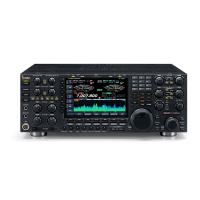3 - 10
• DSP SYSTEM CLOCK CIRCUIT
The 40 MHz reference signal is applied to the amplifier
(IC652) via the “40M” line, and is then applied to the DDS IC
(IC651, pin 7) as the system clock signal. The signals which
are output from pins 14–22 are applied to the D/A convertor
(R661–R671, R673–R681), and then passes through the
low-pass (L681, L682, C680–C685) and high-pass (L683,
C686–C688) filters to suppress unwanted signals. The fil-
tered signal is amplified at the buffer amplifier (Q680), and
passes through the attenuator (R690–R692). The signal is
applied to the DSP IC for TX (DSP-TX board; IC1), RX-A
(DSP-A board; IC1) and RX-B (DSP-B board; IC1) as
12.288 MHz system clock signal via the A/D converters.
• RXPLL-A/B CIRCUITS
*VCO is composed as below.
Q220: 64.485–72.454999 MHz
Q230: 72.455–79.454999 MHz
Q240: 79.455–86.454999 MHz
Q250: 86.455–94.454999 MHz
Q260: 94.455–109.454999 MHz
Q270: 109.455–109.455 MHz
*VCO is composed as below.
Q220: 64.585–72.554999 MHz
Q230: 72.555–79.554999 MHz
Q240: 79.555–86.554999 MHz
Q250: 86.555–94.554999 MHz
Q260: 94.555–109.554999 MHz
Q270: 109.555–109.555 MHz

